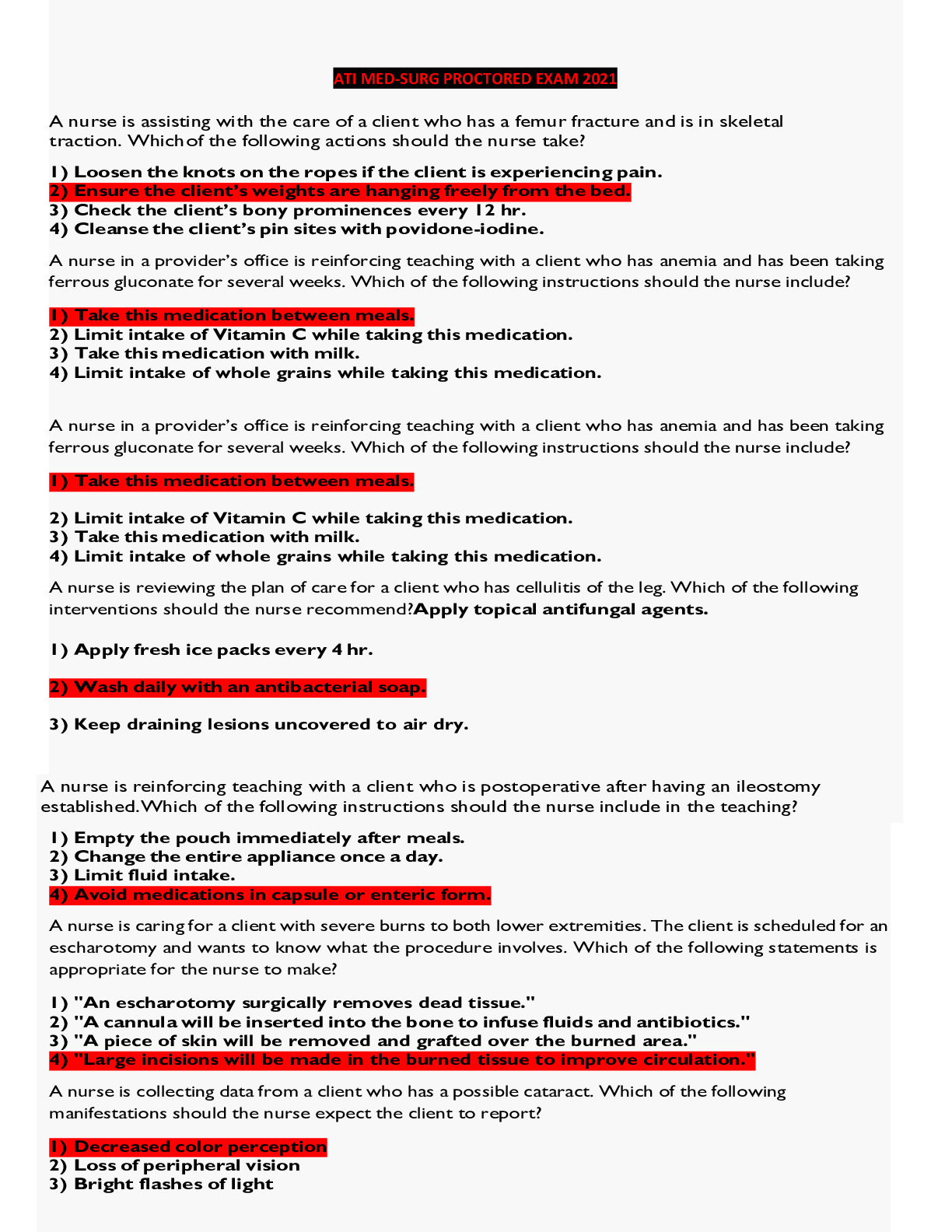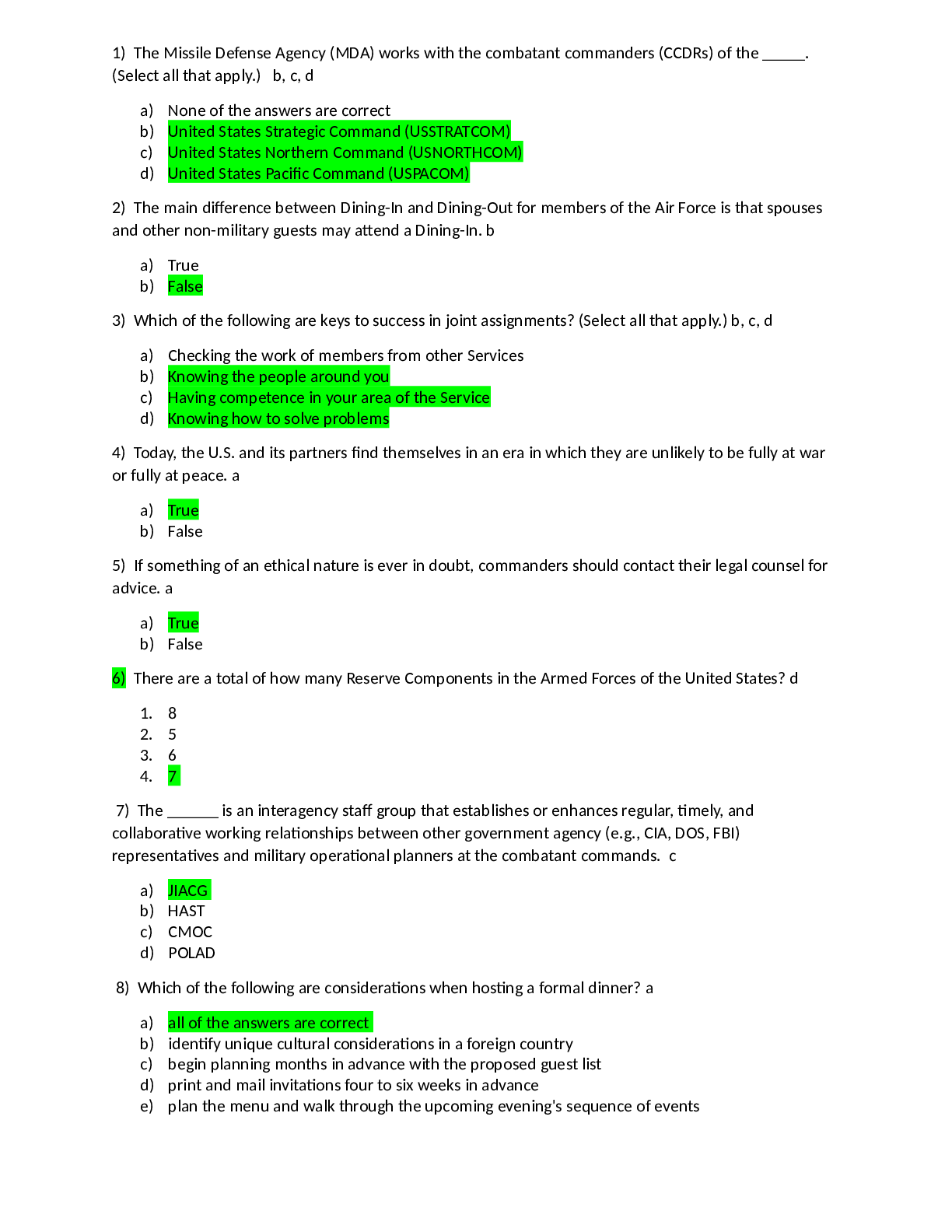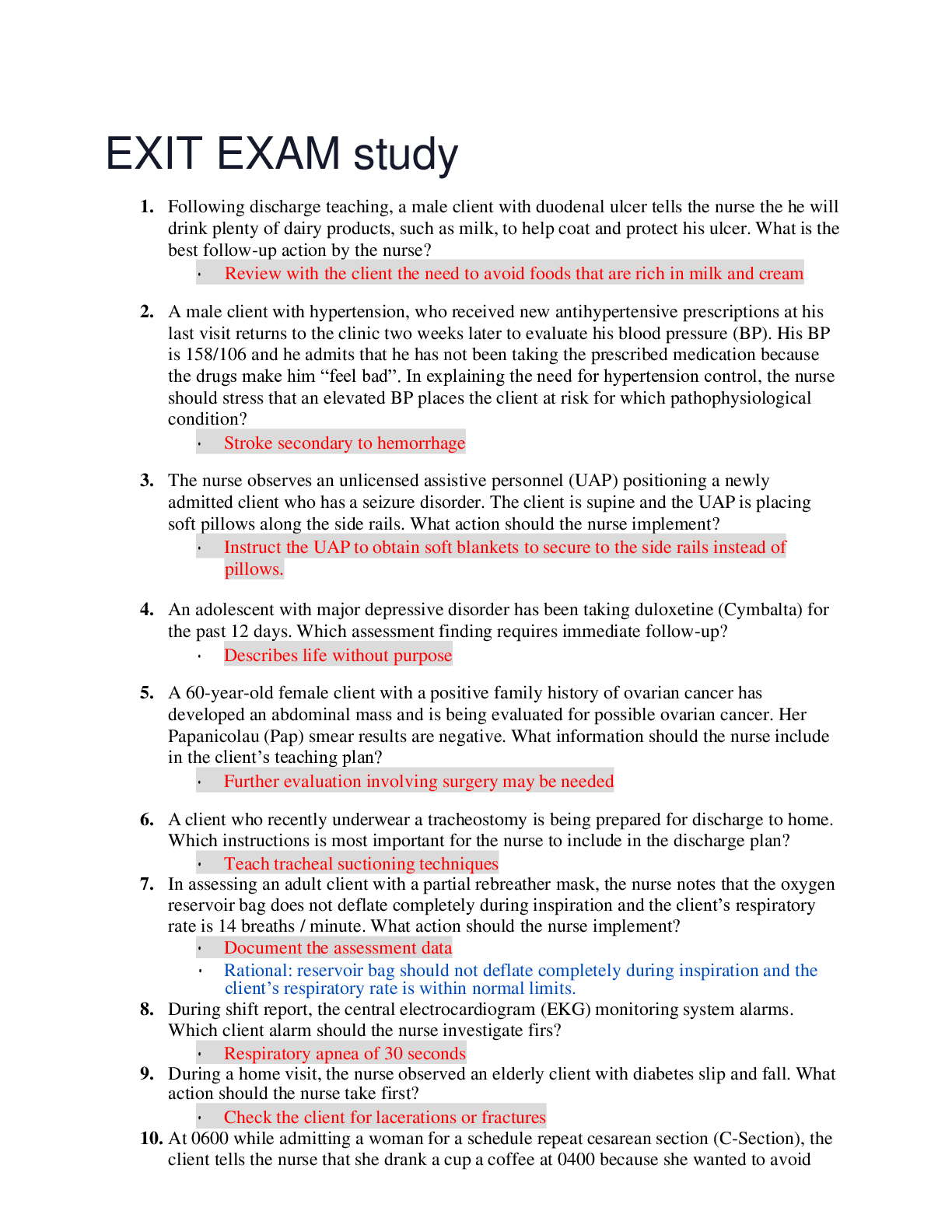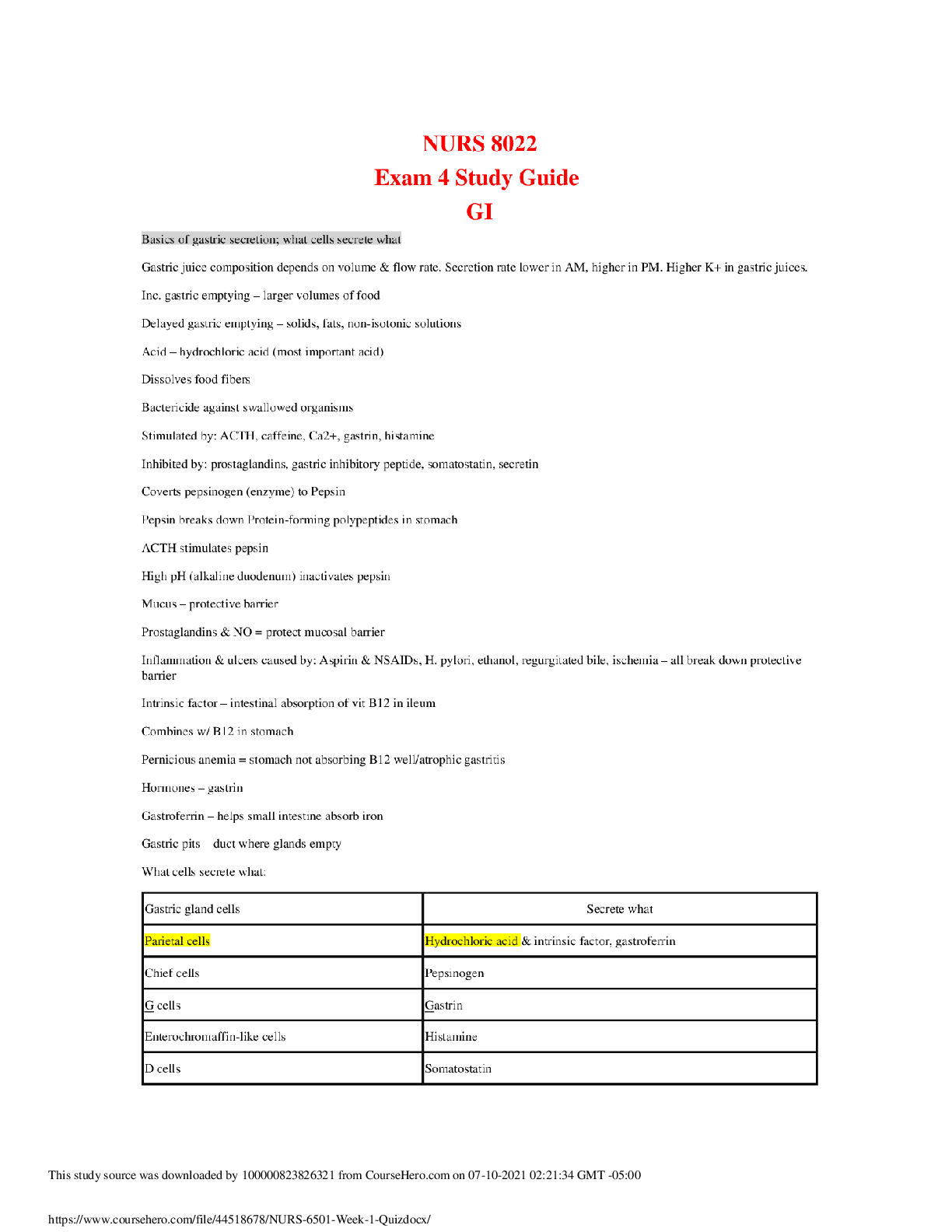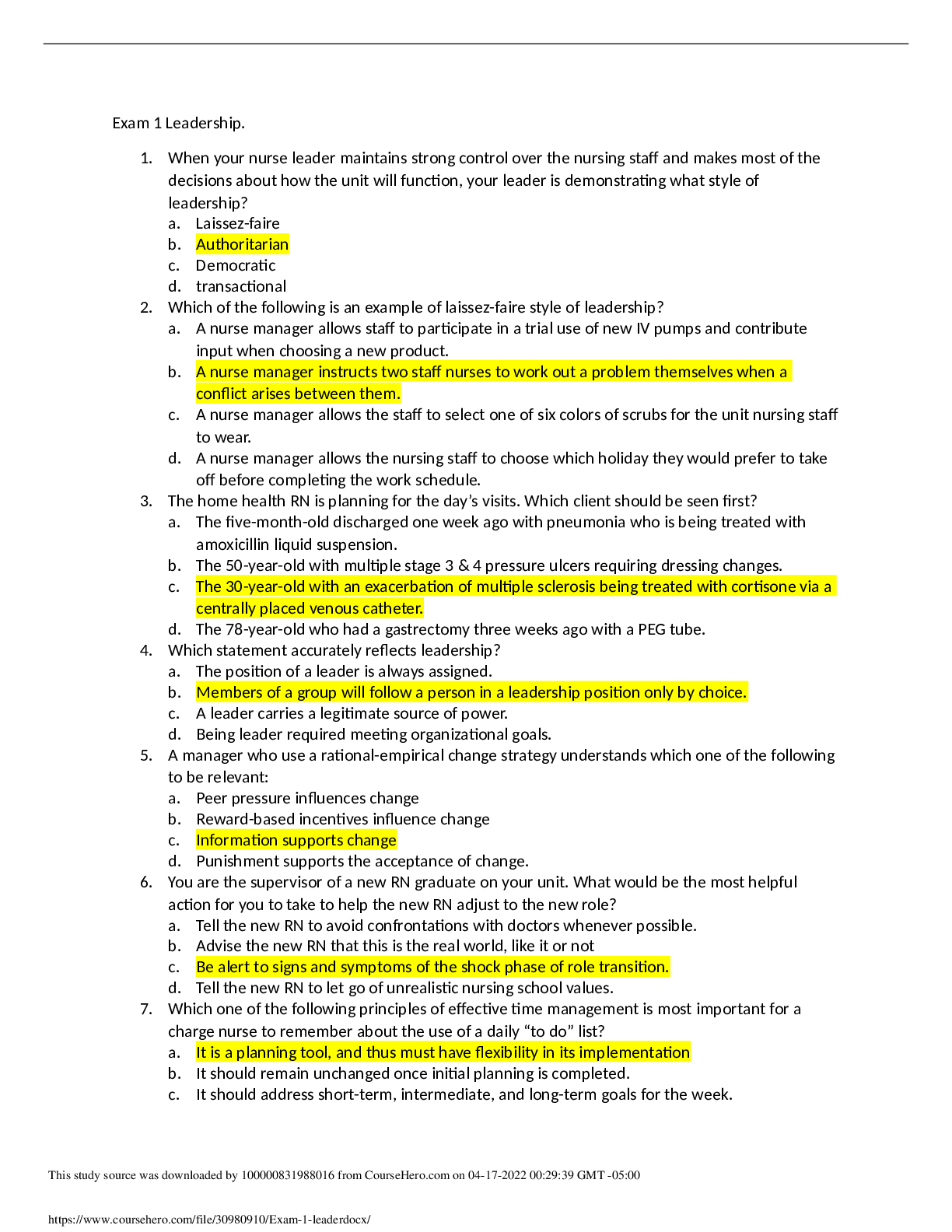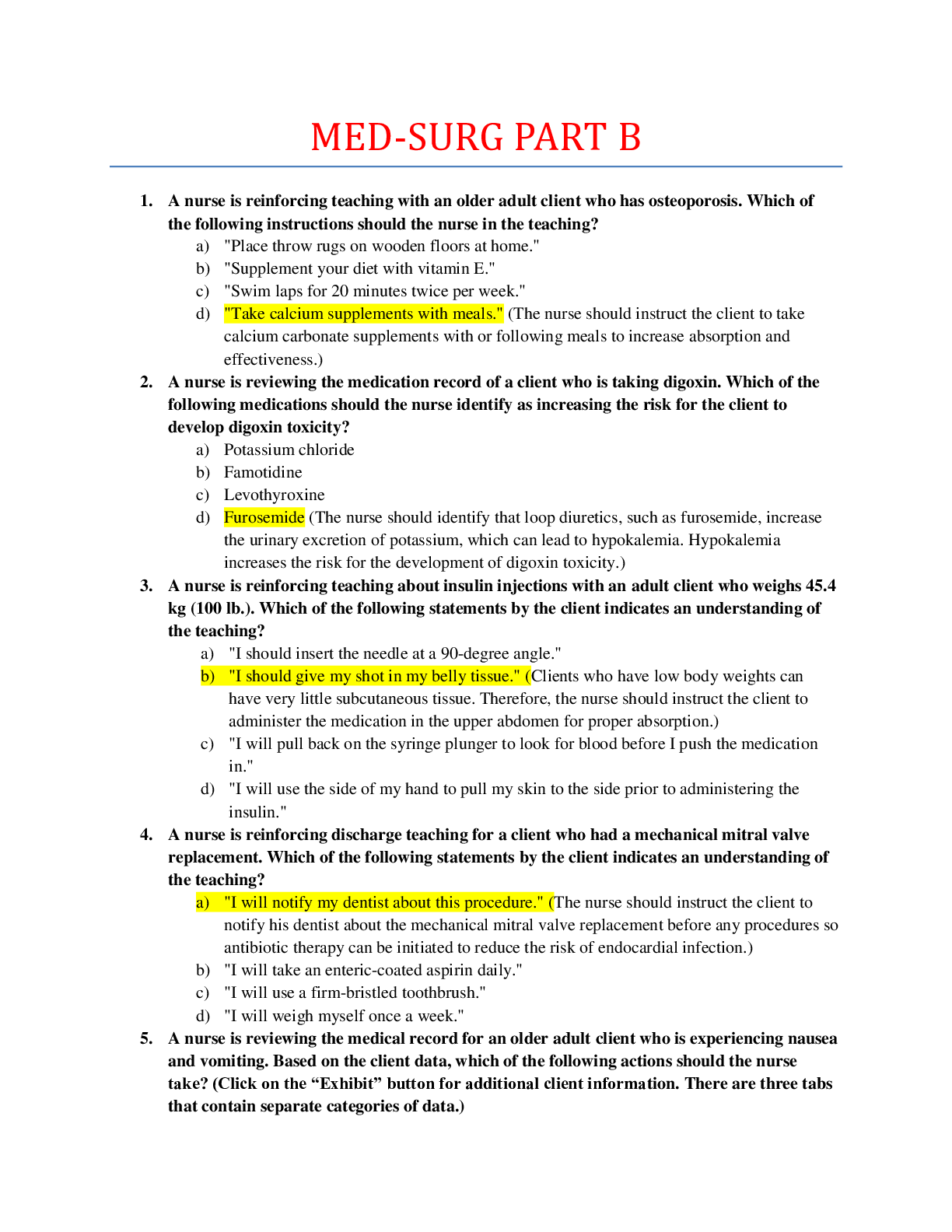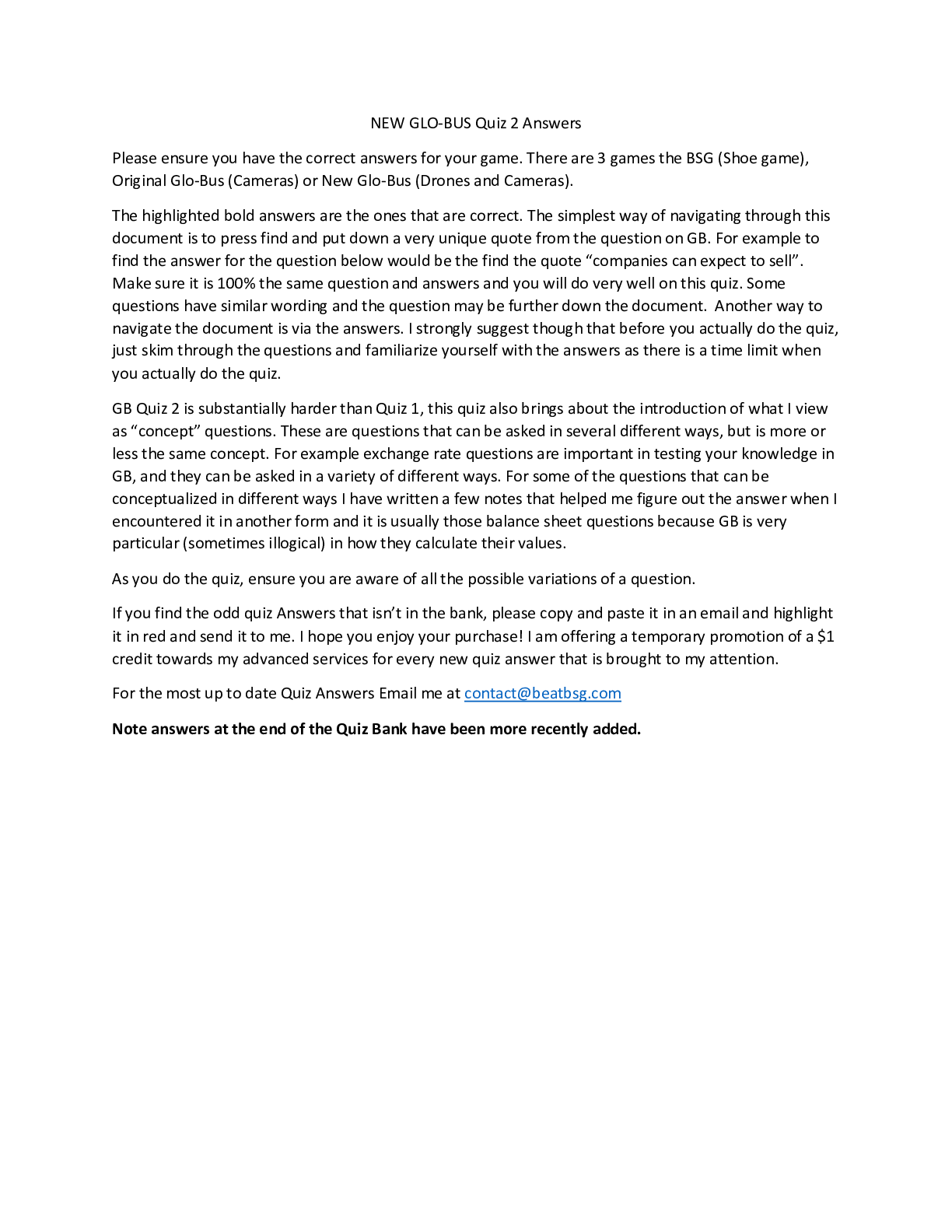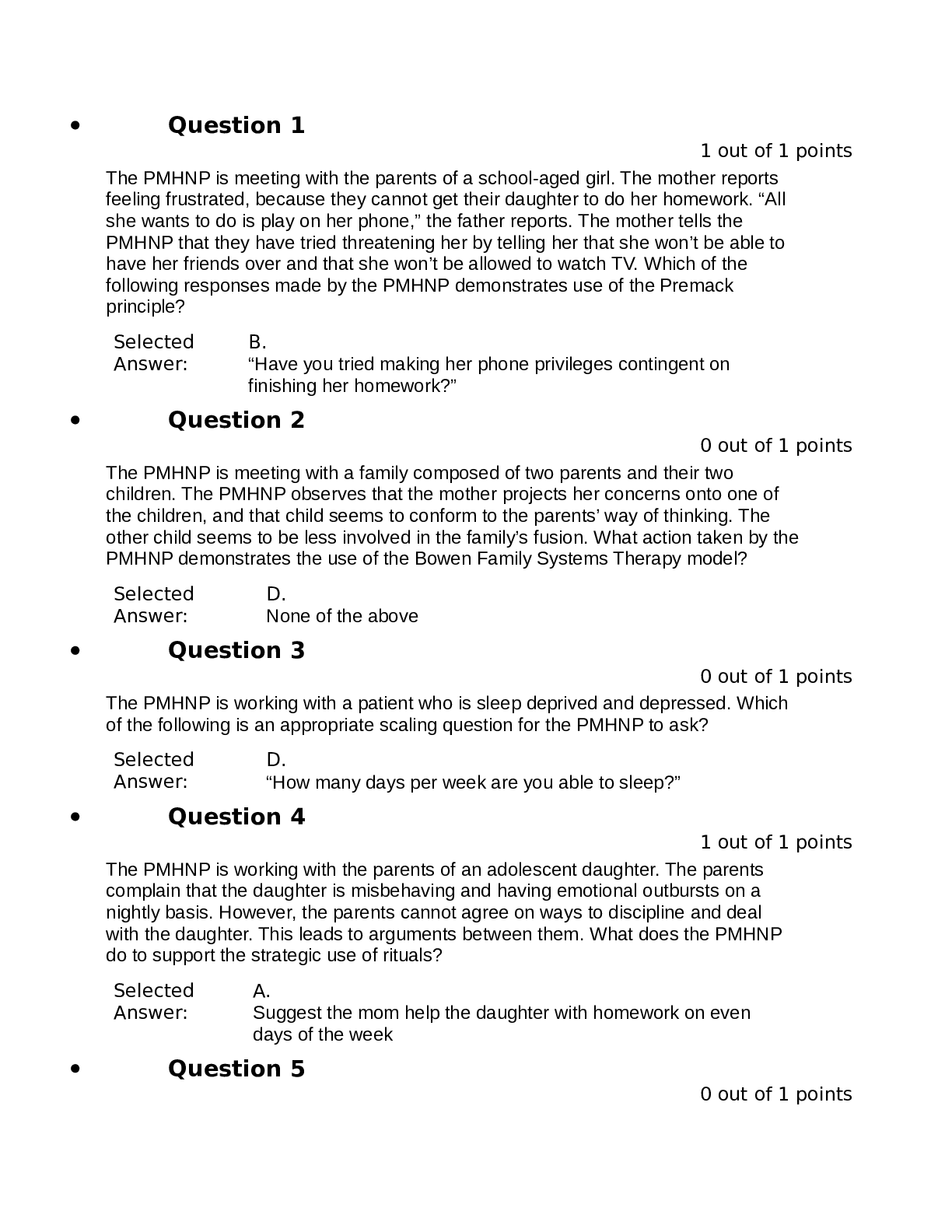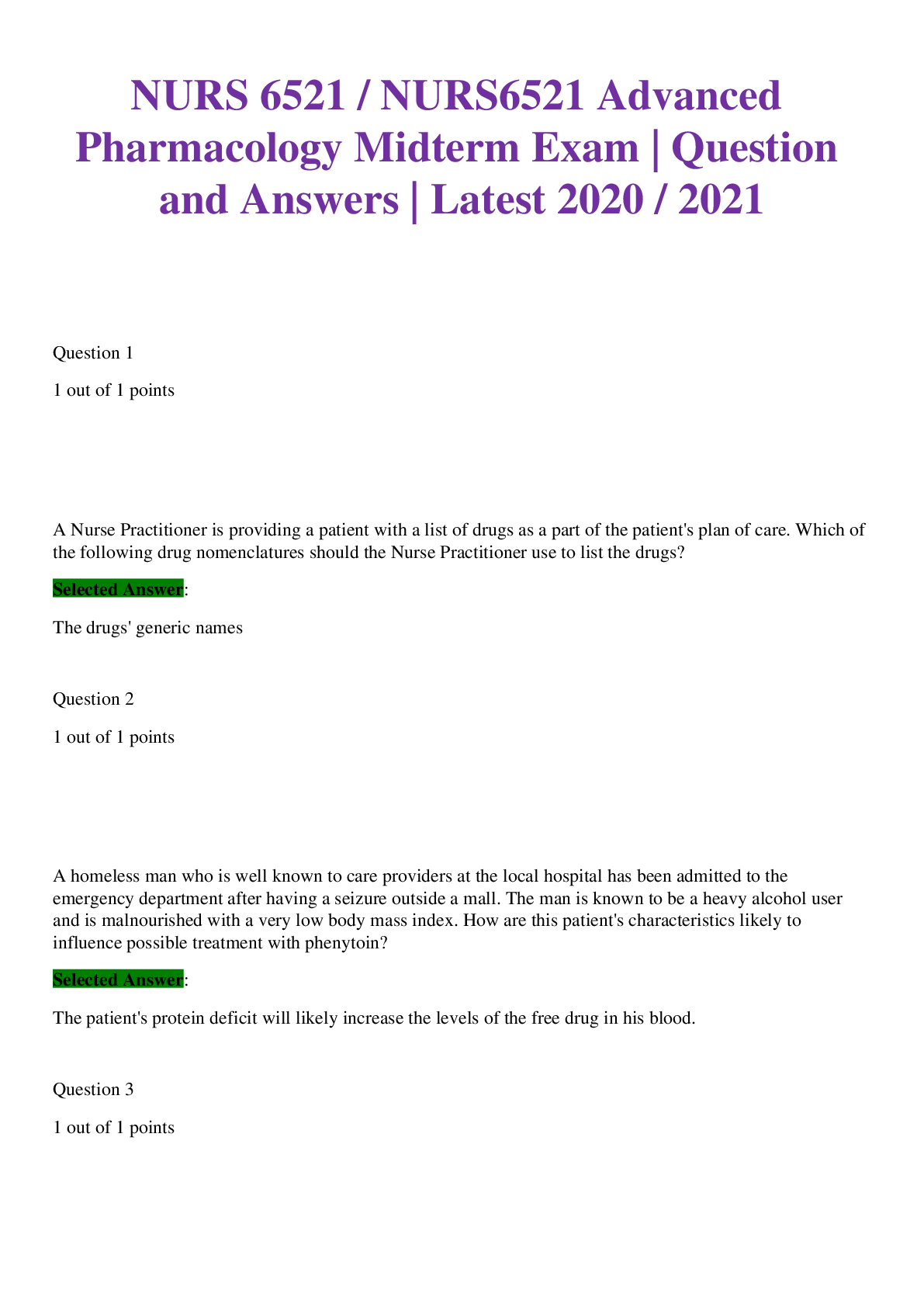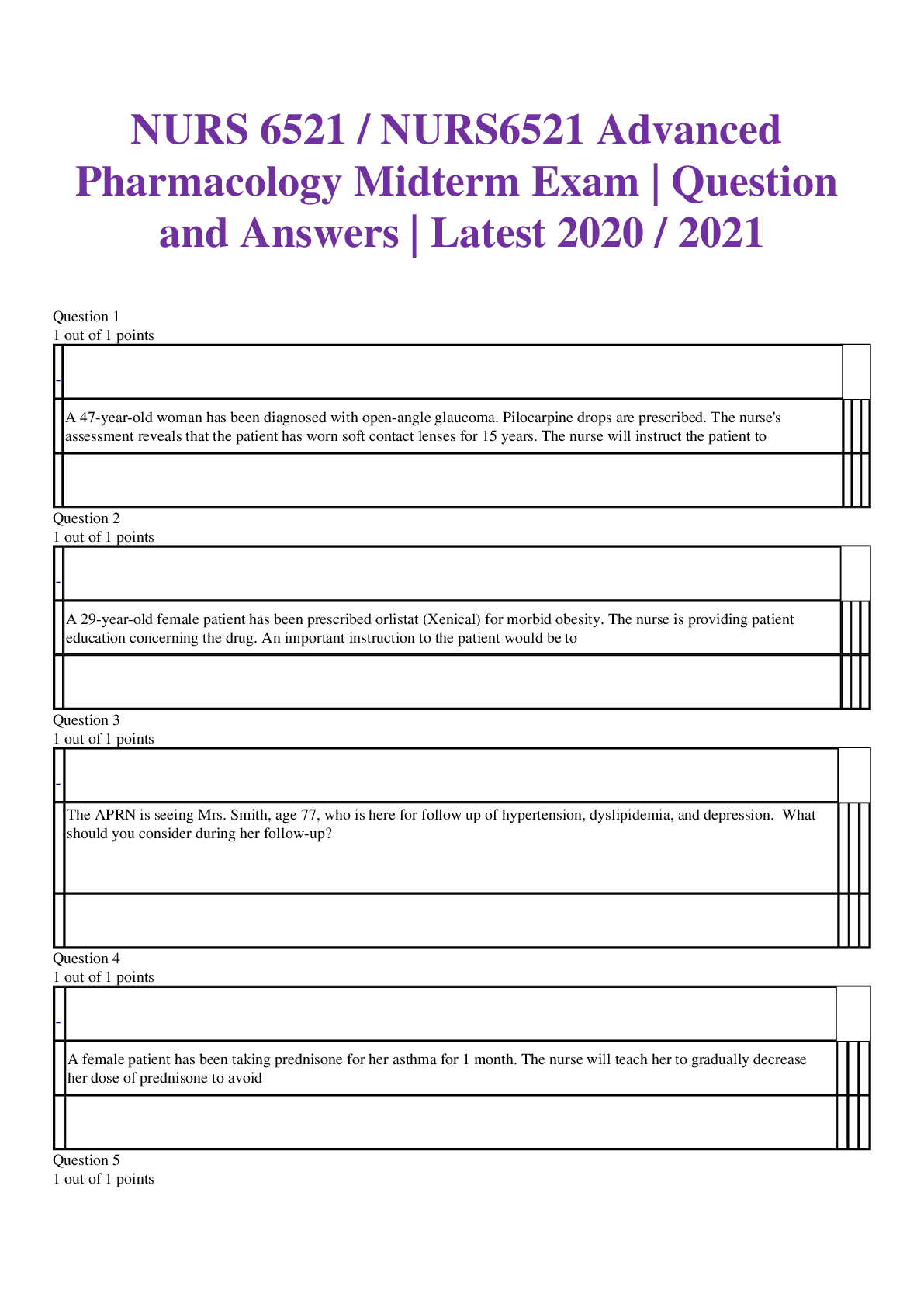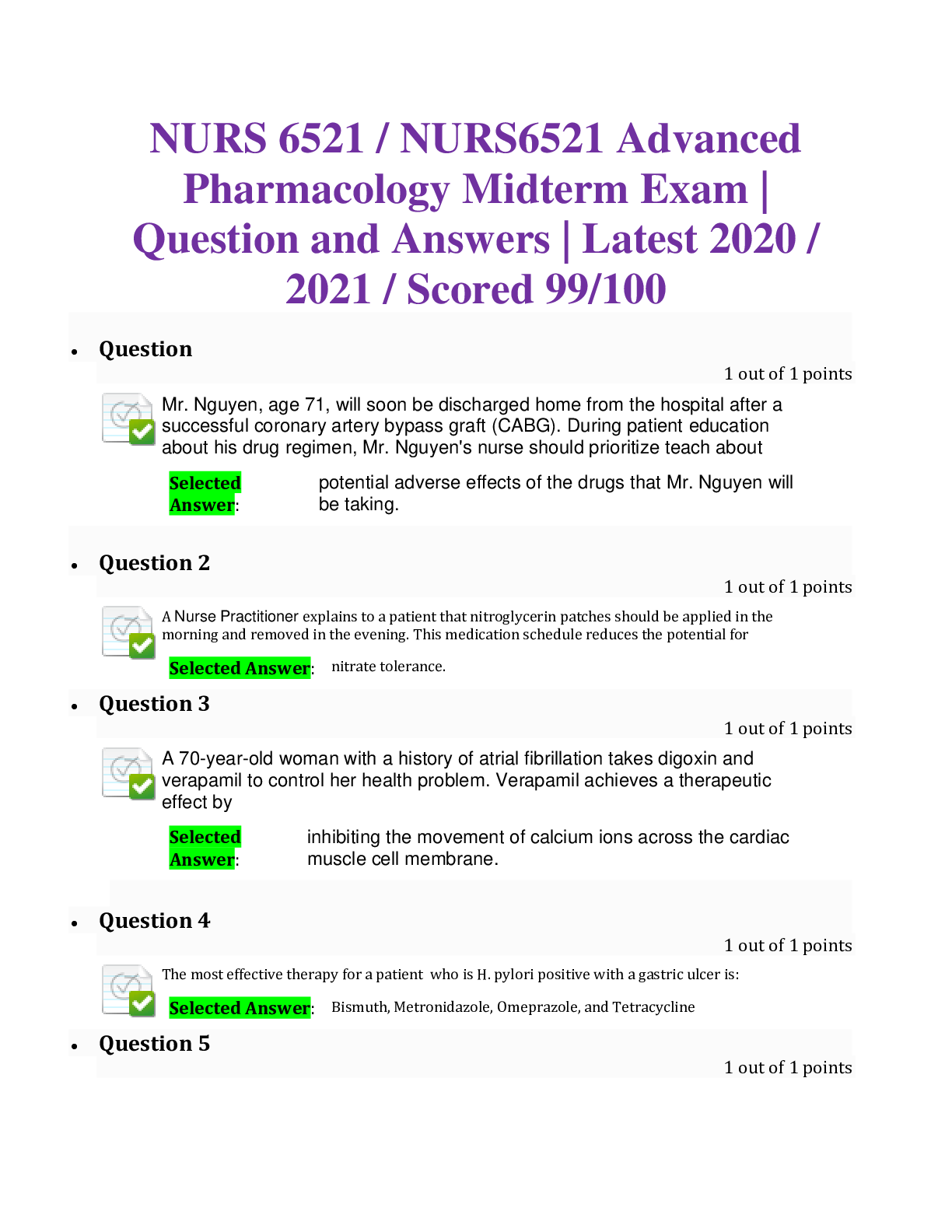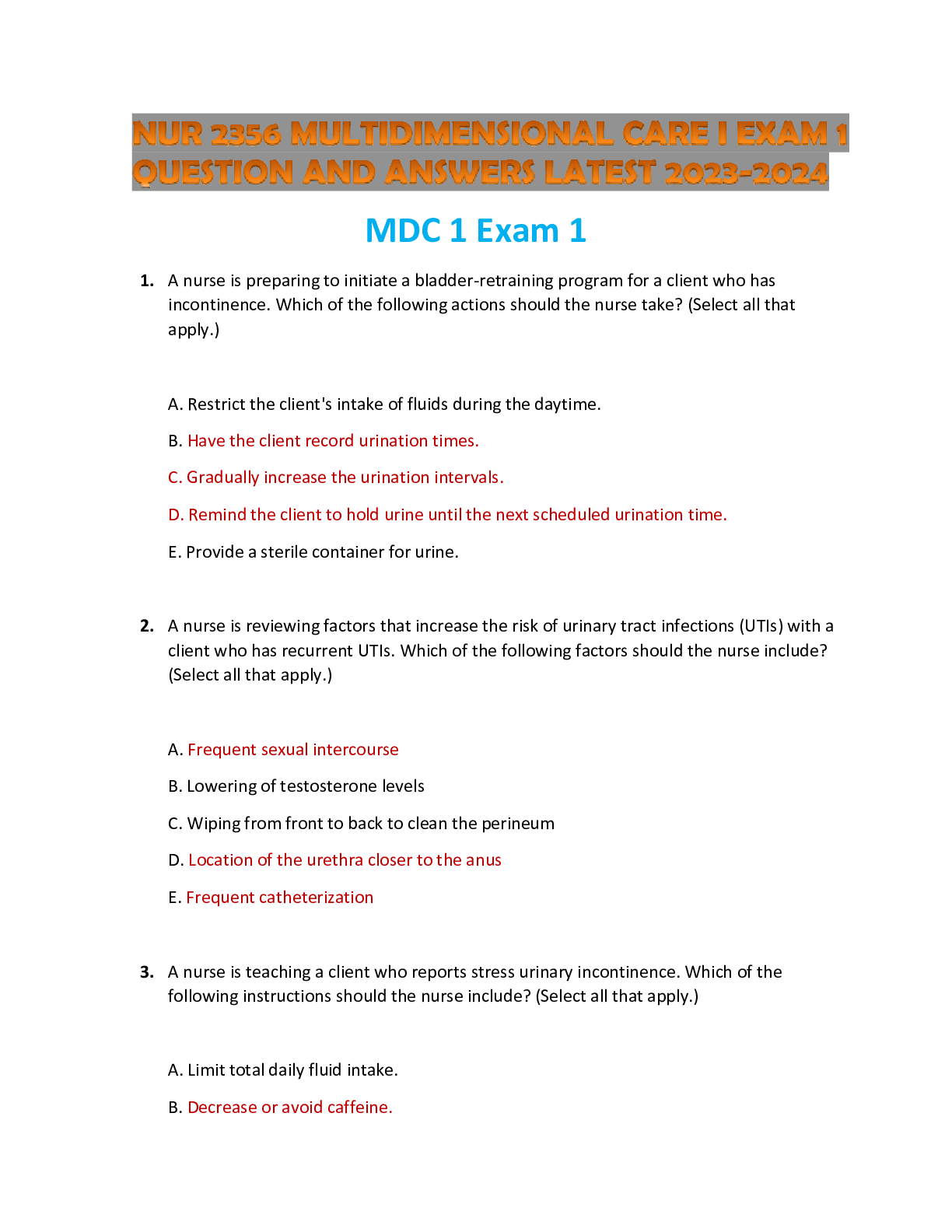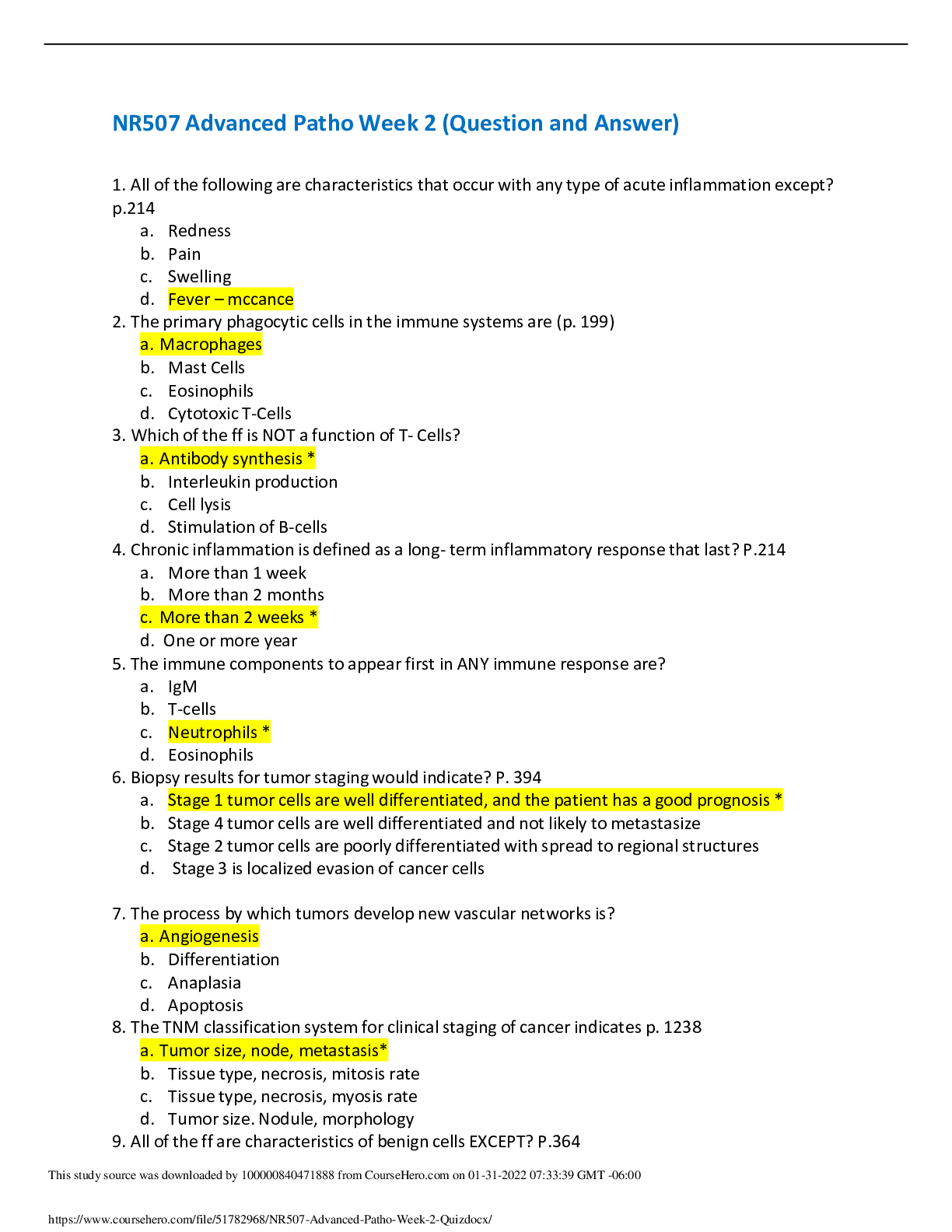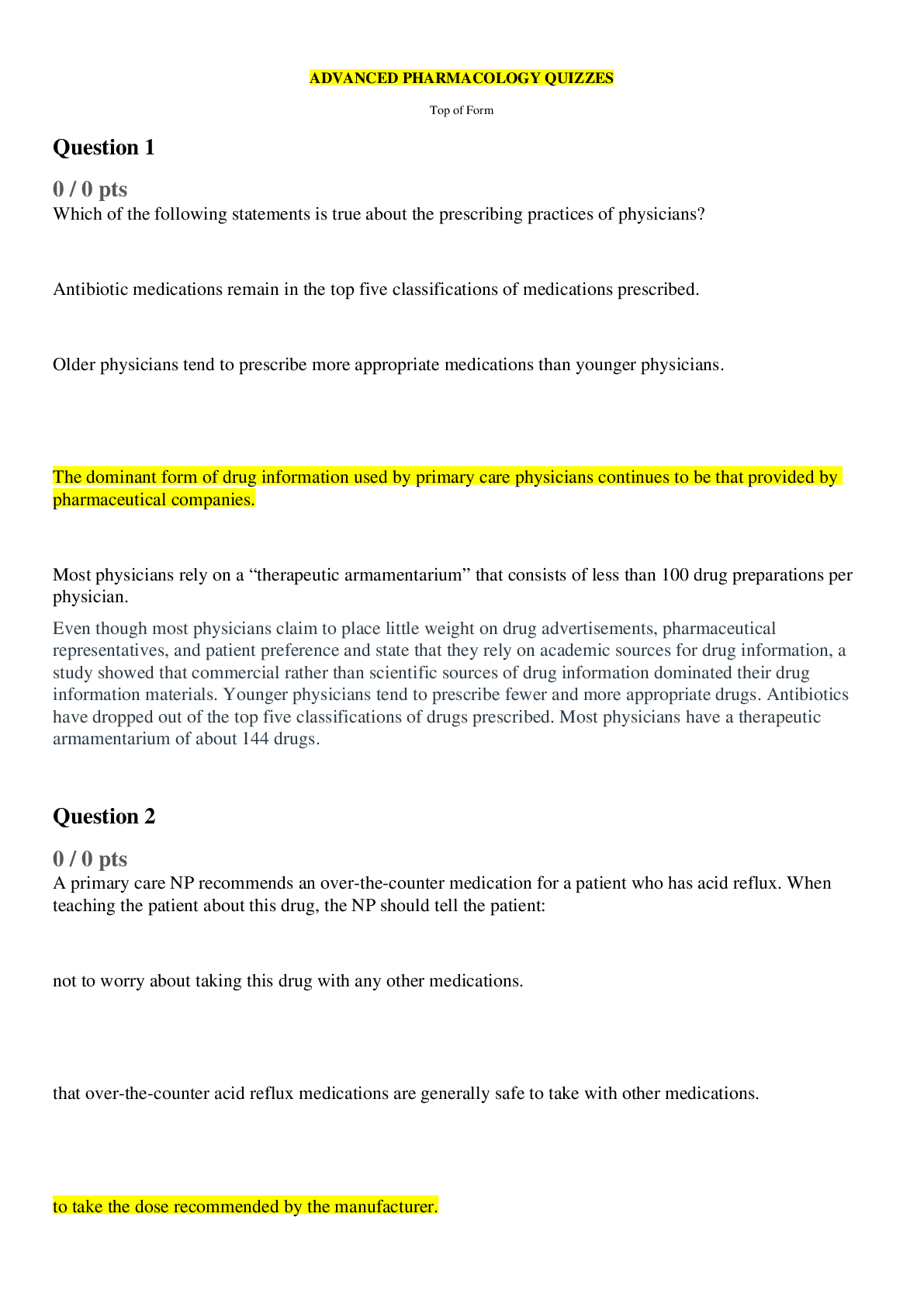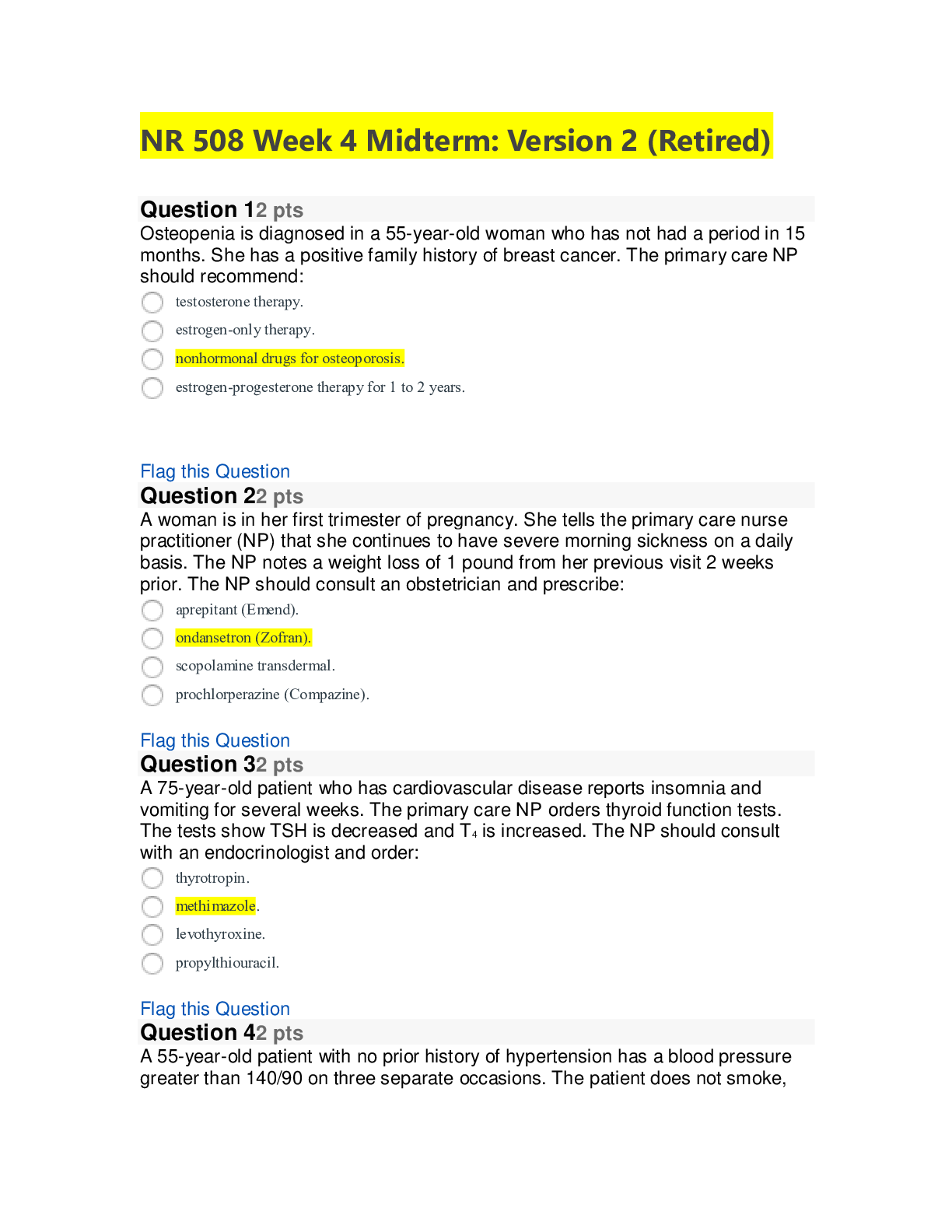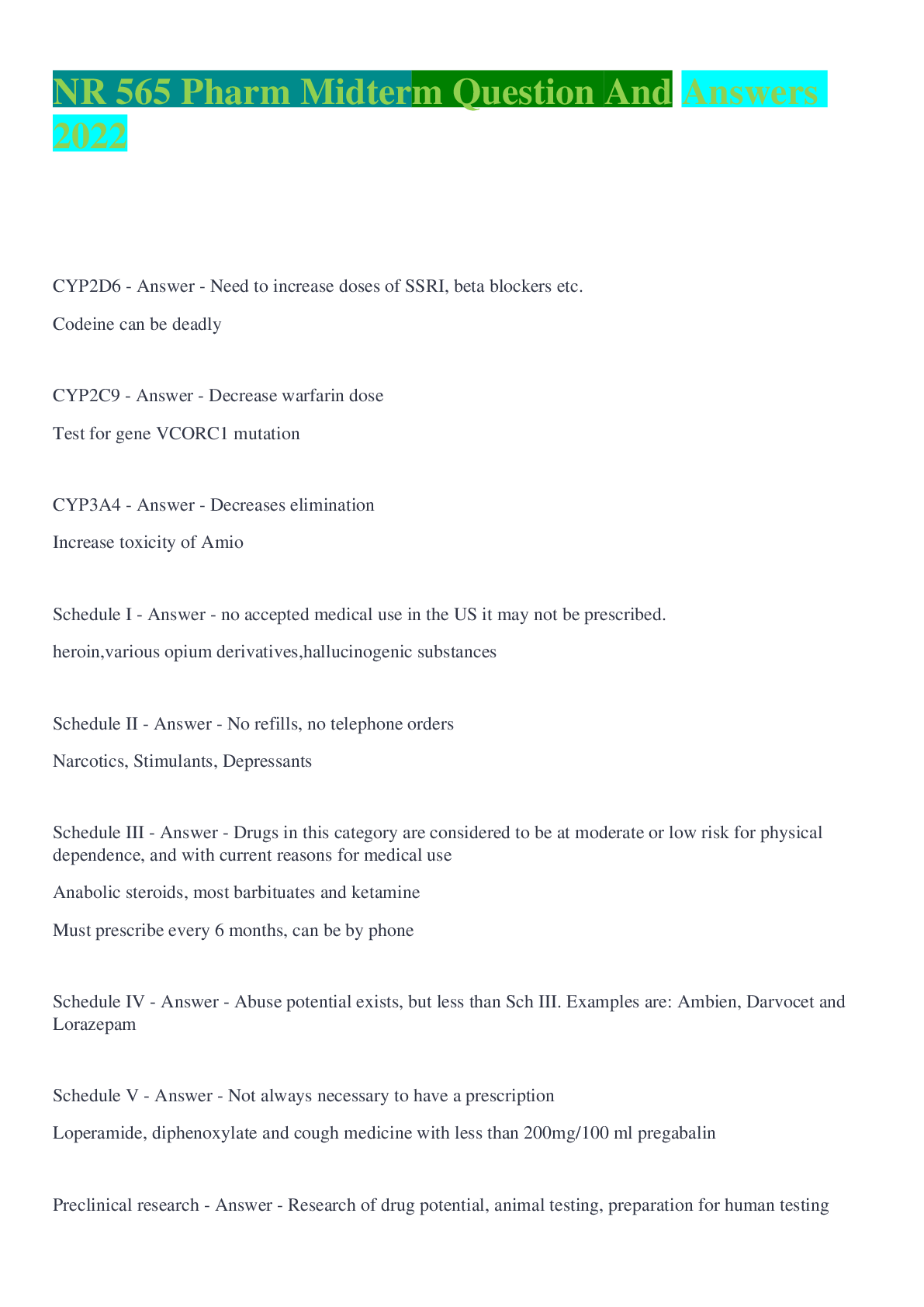Micro Biology > EXAM > Microbiology Test 2 (Chapter 5 - chapter 16) ;100% Verified Question and Answer Solutions | Downloa (All)
Microbiology Test 2 (Chapter 5 - chapter 16) ;100% Verified Question and Answer Solutions | Download To Score An A.
Document Content and Description Below
(chapter5) Microbiology Test 2 1. Which growth phase has the largest increase in cell numbers per unit of time? death phase exponential phase lag phase stationary phase In which growth p... hase is there no increase or decrease in cell number because some cells are dividing while others are dying? death phase exponential phase lag phase stationary phase To speed up the growth rate in a chemostat, the should be increased. To increase the cell density as well, the should be increased. A. dilution rate / dilution rate B. dilution rate / limiting nutrient C. limiting nutrient / dilution rate D. limiting nutrient / limiting nutrient The exact composition of media is known. media inhibit the growth of some microbes. media are used to culture fastidious microbes, particularly pathogens. A. complex / Differential / Selective B. complex / Enriched / Differential C. defined / Selective / Enriched D. defined / Enriched / Differential What happens when a culture is incubated above the organism's maximum temperature for growth? A. The cell continues to grow at the normal rate. B. The cells grow much faster than normal because the enzymatic reactions are occurring at a much faster rate. C. The cell membranes collapse, proteins denature, and the cell usually dies. D. The transport of nutrients into the cell is slow; therefore, the cells grow more slowly than normal. Which of those listed below is NOT classified as a cardinal temperature? A. lethal temperature B. maximum temperature C. minimum temperature D. optimum temperature is used to reduce microbes in food products to increase shelf life, and is routinely used to sterilize a variety of food products, surgical supplies, and laboratory equipment. A. Ionizing radiation / pasteurization B. UV radiation / cold sterilization C. Steam heat / UV radiation D. Pasteurization / ionizing radiation (chapter6) The upstream region of an mRNA, acting as a riboswitch, binds a(n) and results in translational blockage of the downstream protein-encoding sequence. a. antisense RNA b. metabolite c. peptide d. RNAi Attenuation is a transcriptional control mechanism that relies on a. attenuator molecules binding to mRNA. b. effector proteins to control the binding of RNA polymerase. c. transcriptional feedback inhibition. d. the secondary structure of the mRNA leader. Binding of an sRNA to the RBS a. inhibits translation of the mRNA. b. stimulates translation of the mRNA. c. can inhibit or stimulate translation of the mRNA. d. inhibits transcription of the mRNA. True or False: sRNAs can only regulate expression by binding mRNA. a. TRUE b. FALSE Which RNA chaperone protein binds the short trans-sRNA sequence to form a complex with its mRNA target? a. TrpC b. Hfq c. SgrS d. RpoS occurs when an external signal does NOT directly enter the cell but instead is detected by a sensor that transmits it to the rest of the regulatory machinery. a. Quorum sensing b. Sensory transduction c. Signal transduction d. Two-component regulation The is a bacterial regulatory mechanism used to survive nutrient-poor conditions, antibiotic exposure, and environmental stresses. a. catabolite repression b. heat shock response c. stringent response d. two-component system Whereas gram-negative bacteria such as the Proteobacteria often use as autoinducers, quorum-sensing gram-positives more commonly use that act as autoinducers. a. acyl homoserine lactones / short peptides b. acyl homoserine lactones / quinones c. short peptides / acyl homoserine lactones d. quinones / acyl homoserine lactones Once a signal from the environment is detected by a sensor kinase, the next step to pass on this signal involves the sensor kinase transferring a. its phosphate to ADP to form ATP. b. its phosphate onto another intracellular signaling molecule. c. phosphate from ATP onto another intracellular signaling molecule. d. phosphate from ATP onto itself. The differentiating mechanism between a flagellar response to a chemoattractant or a chemorepellent involves the activity being low or high (respectively) on . a. autophosphorylation / CheA b. autophosphorylation / MCPs c. demethylation / CheA d. demethylation / MCPs Where do transcriptional regulators most commonly bind to? a. major grooves in dsDNA b. minor grooves in dsDNA c. primary supercoils d. promoter sequences A common motif in proteins that bind DNA in Bacteria is the a. catalytic triad. b. double helix. c. helix-turn-helix. d. turn-helix-turn. In positive control regulation, the activator protein binds to the site to induce transcription. a. activator-binding b. operator c. promoter d. repressor Which of the following is NOT true of DNA-binding proteins? a. Many are dimers that combine with two sites on the DNA. b. Regulatory proteins often bind inverted repeats on DNA. c. A leucine zipper is a common domain to maintain proper conformation. d. Most bind to DNA in a nonspecific manner. Which is NOT true regarding transcriptional controls in Archaea? a. Like Eukarya, they use several transcription factors to interact with RNA polymerase. b. Their control mechanisms more closely resemble those of Bacteria than Eukarya. c. Archaeal repressor proteins block the binding of RNA polymerase or of TBP and TFB. d. Archaeal activator proteins recruit TBP to the promoter Which control mechanism is responsible for Escherichia coli using glucose as a carbon substrate and NOT inducing other pathways? a. catabolite induction b. catabolite repression c. signal transduction d. stringent response In E. coli, the genes for utilization of maltose are at various locations across the chromosome but are activated by the same maltose activator protein. This is an example of a(n) a. operon. b. regulon. c. riboswitch. d. two-component regulatory system. In the hyperthermophile Pyrococcus furiosus, TrmBL1 simultaneously represses genes for and activates genes for synthesis. a. nitrogen fixation / glutamine b. glutamine synthesis / nitrogen c. nitrogen assimilation / arginine d. sugar transport / glucose Pathogenic bacteria such as E. coli O157:H7 and Staphylococcus aureus have a strong selection pressure to refrain from activating an immune response until their numbers are great. is thus an effective way these pathogens control production of certain virulence factors. a. Attenuation b. Differentiation c. Signal transduction d. Quorum sensing In Escherichia coli, the cytoplasmic heat shock response is facilitated by σ32 (RpoH), which at high temperatures a. binds to DnaK and degrades proteases. b. binds to unfolded proteins, acting as a chaperone. c. evades protease degradation and functions to induce heat shock gene expression. d. remains unbound and acts as a negative regulator to synthesize DnaK. True or False: In enzyme induction, an enzyme is made only when its substrate is absent. a. TRUE b. FALSE True or False: Often it is the final product of a biosynthetic pathway that acts as a corepressor molecule. a. TRUE b. FALSE True or False: Even when a gene or operon is "fully repressed," some basal level of transcription still occurs. a. TRUE b. false Induction often occurs for pathways, whereas repression is more common in pathways. a. anabolic / biosynthetic b. anabolic / catabolic c. biosynthetic / anabolic d. catabolic / anabolic To repress transcription, corepressors bind to , and inducers bind to proteins. a. repressor proteins / inducer b. repressor proteins / repressor c. RNA polymerase / inducer d. RNA polymerase / repressor For the lac operon in E. coli, under conditions in which glucose is absent and lactose is present, which of the following is true? a. CRP and cAMP together are bound to the DNA, and LacI is bound to the operator site. b. The lac operon is not transcribed because lactose is present. c. CRP and cAMP together are bound to the DNA, and allolactose is bound to LacI. d. The lac operon is not transcribed due to catabolite repression because glucose is absent. (chapter 7) Which of those listed below is NOT a major target for antibiotics? A. protein translation B. peptidoglycan synthesis C. cytoskeleton synthesis D. nucleic acid synthesis Which antibiotic inhibits transcription by blocking the active site of RNA polymerase? A. streptomycin B. cephalosporin C. ciprofloxacin D. rifampin Which of the following antibiotics does NOT target peptidoglycan synthesis? A. bacitracin B. penicillin C. vancomycin D. streptomycin Polymyxins target and thus are effective against bacteria. A. LPS / gram-negative B. LPS / gram-positive C. peptide interbridges / gram-negative D. peptide interbridges / gram-positive Quinolones like ciprofloxacin inhibit DNA gyrase and topoisomerase IV and thus A. interfere with unwinding of DNA during replication. B. result in the ribosome misreading mRNAs. C. lead to pore formation and depolarization of the cell membrane. D. cause a shortage of peptidoglycan precursors that weakens the cell wall, leading to lysis. Which is NOT a class of antibiotic resistance mechanism? A. modification of the drug target B. removal from the cell via efflux pump C. disruption of membrane structure D. enzymatic inactivation Antibiotic resistances are often acquired by A. horizontal gene transfer. B. spontaneous mutations. C. movement of mobile genetic elements. D. all of the above. For clinical medicine, a major consequence of phenotypic heterogeneity within populations of pathogens is the existence of A. dormant cells that can cause reinfection after the pathogen was thought eradicated. B. cells that produce higher levels of toxins. C. cells that undergo endospore germination at different rates. D. cells that can sequester iron more efficiently. (Chapter 8) The extracellular state of a virus is referred to as a a. virion. b. viroid. c. capsid. d. lysogen. Viral genomes can be a. linear or circular. b. double-stranded or single-stranded. c. composed of RNA or DNA. all of the above A viral capsid is composed of individual units of called . a. polysaccharides / viroids b. proteins / capsomeres c. glycolipids / viroids d. polysaccharides / capsomeres The two types of structural symmetry in viruses are rod-shaped and (spherical) symmetry. a. bacillus / coccus b. coccus / bacillus c. helical / icosahedral d. icosahedral / helical RNA virus genomes may be either a. plus sense or minus sense. b. nonsense or missense. c. negative or positive. d. double-stranded or triple-stranded. The term is used to reference concentrations of viruses. a. titer b. viral particle c. virion d. viroid A plaque assay uses the technique. a. agar overlay b. colony-plate c. streak-plate d. spot titering What is an effective way of growing an animal virus? a. in lysogeny broth (LB) b. in a primary cell culture c. on a tryptic soy agar medium You cannot grow animal viruses Which is NOT true regarding plaque assays? a. Viral titers are expressed as plaque-forming units (PFU). b. Top agar containing a dilution of virions and bacteria is poured on an agar plate. c. Plaques are clear zones seen because viruses lysed the host cells in the area. d. Plaque assays are used to quantify lysogenic phages as well as lytic phages. Why is plating efficiency an important metric of consideration in quantitative measurements of virus? a. Not all host cells are susceptible to viral infection. b. Prophage need to be accounted for. c. Virions do not infect host cells with 100 percent efficiency. d. All of the above are correct. The targets of the T4 bacteriophage during attachment to Escherichia coli are a. iron-uptake proteins. b. maltose-transport proteins. c. carbohydrates in the LPS layer of the outer membrane. d. appendages of the cell, pili, and flagella. During penetration of an Escherichia coli cell by the T4 bacteriophage, a. the envelope fuses with the cell membrane, allowing the phage nucleocapsid to enter the cell. b. integrase makes a pore in the cell wall, the tail sheath contracts, and the phage DNA is injected into the cell. c. T4 lysozyme makes a pore in the cell wall, the tail sheath contracts, and the phage DNA is injected into the cell. d. T4 lysozyme facilitates membrane fusion, allowing the phage to enter the cell. Why is the T4 genome resistant to restriction enzymes? a. It has an RNA genome. b. It modifies its DNA, using 5-hydroxymethlycytosine instead of cytosine. c. It has an ssDNA genome. d. It modifies its DNA by methylating nu Which is true regarding release of the T4 bacteriophage? a. T4 enzymes compromise the cell membrane and peptidoglycan, causing lysis of the host cell. b. Cro allows the expression of release proteins, leading to host-cell lysis. c. Newly assembled T4 phages are released via a secretion apparatus. d. T4 phages exit via budding, assembling an envelope from the cell membrane. Which is NOT true regarding T4 genome replication and transcription? a. T4 encodes its own DNA replication complex. b. The T4 genome exhibits circular permutation, meaning the arrangement of genes differs. c. The T4 genomes are recombined into a concatemer prior to headful packaging. d. T4 encodes its own RNA polymerase for transcription of phage genes. Which is NOT true regarding temperate phages? a. They always kill their host once infection begins. b. A host with a temperate phage is called a lysogen. c. The genome of a temperate phage inserted into a host’s chromosome is called a prophage. d. They can cause lysogenic conversion, giving new abilities to their host. Lambda DNA is replicated by a. recombination to create concatemers. b. rolling circle replication. c. bidirectional replication. d. transduction. The cI (lambda repressor) protein a. represses the transcription of all other lambda-encoded genes. b. competes with Cro to determine whether a lytic or lysogenic cycle will occur. c. promotes lysogeny. d. does all of the above. If lambda phage were unable to express the Cro repressor protein, what would happen? a. It would be unable to integrate its viral DNA into the host's chromosome. b. It would be unable to maintain the lysogenic pathway. c. It would never enter the lytic pathway. d. It would not be able to express any genes in its genome. If a mutation were to occur in lambda phage that made it unable to express integrase, what would happen? a. It would be stuck in the lysogenic cycle. b. It would be unable to form circular DNA once it entered the host. c. It would be unable to inject its DNA into the host. d. It would be unable to recombine with the bacterial chromosome. The enzyme is used by retroviruses to transfer information from RNA to DNA. a. RNA polymerase b. reverse transcriptase c. integrase d. helicase Which is NOT a difference between bacteriophages and animal viruses? a. Many animal viruses are enveloped. b. Many animal viruses replicate their genome within their host cell’s nucleus. c. Animal viruses are classified by their genome. d. The entire virion of animal viruses enters the host cell. Animal viruses typically enter a cell by a. membrane fusion. b. endocytosis. c. membrane fusion or endocytosis. d. direct penetration. Which is NOT a possible outcome from infection by an animal virus? a. avirulent infection b. persistent infection c. latent infection d. transformation Which is NOT true regarding retroviruses? a. Reverse transcriptase creates dsDNA from the ssRNA genome. b. Integrase inserts the viral dsDNA into the host cell’s genome as a provirus. c. Protease excises the provirus from the host cell genome. d. New nucleocapsids exit the cell by budding. A virus was used to alter human cells. mRNA for a gene was inserted into the virus, and the virus infected the human cells and inserted the gene into the genome of the cell. What type of virus could do this? a. the T4 bacteriophage b. a temperate phage c. a retrovirus d. all of the above (Chapter 9) is the process of determining the order in which nucleotides are arranged in a genome. a. Ordering b. Sequencing c. Cultivating d. Annotating The first DNA genome sequenced was from a a. virus. b. bacterium. c. human. d. fungus. Computers are used to assemble genomes by deducing the order of DNA fragments based on a. sequence. b. mass spectrometry. c. overlaps. d. well position. A newer sequencing approach called pyrosequencing exploits the function of to detect nucleotide incorporation in the strand's complementary sequence. a. luciferase b. mass spectrometry c. radioactivity d. stable isotopes Potential ORFs are identified by locating a. OGREs. b. DNA sequences. c. genes. d. start and stop codons. The genome shared by all strains of species is referred to as the , and all of the mobile genetic elements in a genome together are called the . a. pan genome / plasmidome b. complete genome / pan genome c. species genome / transient genome d. core genome / mobilome Which of the following is/are mechanisms of horizontal gene transfer? a. transformation b. transduction c. conjugation d. all of the above If one particular gene has a dramatically different from others within an organism's genome, it is likely that the gene was acquired via horizontal gene transfer. a. AT content b. GC content c. codon bias d. All of the above are correct. A new gene is most likely to arise as a result of a(n) event. a. duplication b. inversion c. splicing d. transversion A(n) is a gene or protein shared by two or more taxa as a result of ancestry, whereas a(n) is a similar gene or protein resulting from a duplication event. a. homolog / ortholog b. ortholog / paralog c. paralog / homolog d. xenolog / homolog True or False: To date, humans have been identified as having the largest genome size. a. TRUE b. FALSE Microorganisms with the smallest genomes identified are generally a. autotrophic. b. bacillus-shaped. c. marine. d. parasitic. If you compare a bacterium and a eukaryote of the same genome size, a. the bacterium likely has more insertion elements. b. the bacterium likely has more genes. c. the eukaryote likely has more metabolic pathways. d. all of the above are true. genes are typically the most abundant class of genes found in prokaryotes. a. Metabolic b. Structural c. Protein-synthesis d. Regulatory Which is true regarding genomes of Archaea? a. Archaeal genomes are generally larger than those of Bacteria. b. Unlike Bacteria, Archaea do not show a strong correlation between genome size and ORF content. biosynthesis. d. Archaea have fewer genes for energy and coenzyme production. True or False: In comparison to chloroplast genomes, mitochondria generally encode for fewer proteins. a. TRUE b. FALSE Which of the following genes are present in mitochondrial genomes but absent in chloroplast genomes? a. oxidative phosphorylation genes b. rRNA genes c. tRNA genes d. all of the above The genome of the single-celled eukaryote Saccharomyces cerevisiae is made up of chromosome(s). a. a single linear b. a single circular c. 2–5 circular d. 16 linear Yeast genes contain introns than those of most eukaryotic organisms. a. more b. fewer c. longer d. duplicated True or False: Mitochondrial genomes typically encode all of the proteins necessary for energy generation by oxidative phosphorylation. a. TRUE b. FALSE Which type of analysis is typically used for proteomics? a. RNA-Seq b. microarrays c. multiple displacement amplification d. mass spectrometry Which of those listed is most informative of a cell's metabolic potential function within a microbial community? a. single-cell genomics b. interactomics c. proteomics d. transcriptomics To study an organism's transcriptome by microarray, is hybridized onto DNA silica chips containing gene sequences that are to the sequence. a. cDNA / complementary b. cDNA / identical c. mRNA / complementary d. mRNA / identical Which is NOT a use for metagenomics? a. studying possible connections between specific microbial populations in humans and specific diseases b. assembling complete genomes from isolated community DNA c. measuring gene expression in populations in order to elucidate function of a gene d. analyzing environments for the presence and distribution of specific microbial groups Which is NOT true about the metabolome and metabolomics? a. The metabolome is the complete set of an organism’s metabolic intermediates. b. The metabolome shows the enzymatic pathways of an organism. c. Metabolomics has been used to characterize the human skin microbiome. d. Metabolomics was used to reveal the presence of fungi in the human gut microbiome. Chromosomal islands have which of the following properties? a. may be responsible for differences between strains of the same species b. may be flanked by inverted repeats c. may contain virulence factors d. all of the above (Chapter 10) Which type of viruses likely experience the highest mutation rates? a. dsDNA b. ssDNA c. ssRNA d. none of the above The smallest known DNA virus, , has a -kilobase -stranded genome. a. megavirus / 1.75 / single b. circovirus / 1.75 / double c. megavirus / 175 / double d. circovirus / 1.75 / single To deal with the absence of RNA-dependent RNA polymerases in host cells, which evolutionary trait(s) have RNA viruses developed to ensure successful replication in host cells? a. They carry RNA replicase in their virions. b. They encode RNA replicase in their genomes. c. They carry RNA replicase in their virions and encode RNA replicase in their genomes. d. They do not infect cells that do not have RNA replicase. The hypothesis of the viral origin of DNA assumes all of the following EXCEPT which one? a. The main genetic material of cells in the RNA world was DNA. b. The main genetic material of cells in the RNA world was RNA. c. Viruses horizontally transferred their DNA genomes to cells. RNA viruses developed DNA as a mechanism to protect their genomes from destruction by cell ribonucleases ‘ A good drug against HIV, a class VI retrovirus, and class VII viruses in general should target a. the reverse transcriptase because both virus types depend on this enzyme to replicate their genomes. b. the replicative form because both virus types need this to successfully replicate. c. both a and b. d. neither a nor b. True or False: In permissive hosts, SV40 virus infection results in the formation of new virions and cell lysis, but in nonpermissive hosts, the viral DNA becomes integrated into host DNA. a. TRUE b. FALSE EACH of the following features makes phage M13 an ideal genetic engineering tool for cloning and DNA sequencing EXCEPT a. rapid lysis of host cells, yielding high virion bursts and multiple copies of cloned DNA. b. small genome size, which facilitates sequencing efforts. c. dsDNA, which is produced in its replicative form.. d. release from host cells without lysis, causing infected cells to act as a continuous source of cloned DNA as long as the culture is maintained. Which of these strategies does phage T7 use to ensure successful infection and replication within a host? a. using host RNA polymerase to transcribe early proteins and then subsequently inhibiting host RNA polymerase activity b. rapidly synthesizing an anti-restriction protein before the entire T7 genome has entered the cell c. processing DNA concatemers using a head-full mechanism d. both a and b Which of the following properties make(s) bacteriophage Mu a good tool for genetic manipulations? a. replication by transposition b. its ability to generate mutations upon integration into the host cell chromosome c. its inability to enter a lytic pathway d. both a and b Which of the following is the FIRST example of virus development in the complete absence of host cell contact? a. production of long, thin tails by the Acidianus convivator virus ATV when released from the host cell b. replication by transposition by bacteriophage Mu c. segmentation of the genome by influenza A virus d. cell transformation by polyomavirus SV40 The mechanisms that reoviruses have evolved to evade the host immune system include ALL of the following EXCEPT a. capping and methylation of virus mRNAs by viral enzymes. b. genome replication within the nucleocapsid. c. the use of host nucleotides for RNA synthesis. d. denaturing of proteolytic enzymes in host lysosomes. Which strategy do viruses with small genomes, such as the MS2 phage, use to make their small genomes more efficient? a. relying on the host to supply RNA replicase for replication b. possessing overlapping genes that encode for multiple proteins c. keeping the number of genes in their genome to a maximum of three d. all of the above Which of the following statements about poliovirus and SARS virus is TRUE? a. Both have a VPg protein that facilitates replication. b. Both form polyproteins that undergo post-translational cleavage. c. Both have 30-kilobase genomes. d. Both have single-stranded plus-sense RNA genomes. ALL of the following are processes involved in the assembly of the rabies virus EXCEPT a. transcription of the rabies virus genome in the nucleus. b. migration of envelope proteins to the cytoplasmic membrane. c. migration of nucleocapsids to cytoplasmic membrane. Coating of nucleocapsids with glycoproteins What triggers new outbreaks of influenza after long periods of apparent immunity to the virus? a. loss of all resistant individuals from the population b. mutation of the influenza virus genome by UV exposure, which results in more virulent strains c. antigenic shifts in the influenza genome, which generate hybrid viruses with surface proteins unrecognized by the immune system d. none of the above True or False: Viroids are made ONLY of proteins, and prions are made ONLY of nucleic acids. a. TRUE b. FALSE Which mechanism have viroids evolved to stay stable outside host cells? a. forming a hairpin-shaped double-stranded molecule with closed ends outside cells b. forming a protein capsid outside cells c. forming a protective polysaccharide sheath outside cells d. all of the above A potential drug for the treatment of prion disease would be a. a protease because prions are made only of protein. b. a ribonuclease because prions are made only of nucleic acid. c. a nucleoside inhibitor to prevent formation of new nucleotides. d. none of the above. In the absence of a suitable receptor, which mechanism do viroids use to enter a host cell? a. attachment to other infectious agents that have the suitable receptors to attach and enter the cell b. entry through an existing open wound c. production of hydrolases to dissolve cell walls d. self-cleavage of RNA into tiny fragments that can passively cross the cell wall, be assimilated into the cell, and reassemble upon entering the cell How do prions enter a host and cause disease? a. Prions are carried by parasites that transmit the infectious prion particle through bites. b. Pathogenic prions promote the conversion of native prion proteins to cause disease. c. The host organism contains a gene that encodes for the same protein as the prion. d. Both b and c are correct. It has been estimated that as many as of the Bacteria in seawater are killed by bacteriophages each day. a. 5 percent b. 10 percent c. 50 percent d. 90 percent When hosts are plentiful, viruses employ a lifestyle, and when host numbers are low, they tend toward a cycle. a. lysogenic / lytic b. lytic / lysogenic c. temperate / virulent d. planktonic / sessile Which of the following is NOT a strategy used by host cells to avoid viral infection? a. modification of the structure of receptor sites b. protection of a receptor by a shield c. evolving altered restriction enzyme systems d. inactivating the host’s antitoxin protein and replacing it with a phage antitoxin protein The major problem in the CRISPR system protecting a prokaryotic cell from viruses is a. that the spacers contain sequences similar to host genes. b. the variability of PAMs. c. that the host must survive the initial infection in order to be immunized. d. that interference acts to degrade the CRISPR transcript. Which of the following is NOT a way that bacteriophages aid pathogens in the human gut? a. lysing pathogens before they can cross the mucous barrier b. transferring antibiotic resistance genes by transduction c. transferring antibiotic resistance genes by lysogeny d. transferring virulence genes by lysogeny Which of the following is TRUE regarding viruses? a. Pox virus replication occurs completely in the cytoplasm. b. Retroviruses have negative-strand ssRNA genomes that are converted to dsDNA. c. Reoviruses typically evolve by antigenic shift and antigenic drift. ϕX174 is a temperate phage that infects Crenarchaeota (chapter 11) How is a mutation distinguished from the broader concept of "DNA damage"? a. DNA damage occurs from chemicals, and mutations are biological mistakes. b. Mutations are always heritable. c. Mutations are always lethal; DNA damage is lethal only sometimes. d. All of the above are true. True or False: Most mutations that occur within cells do NOT negatively affect their metabolic capacity. a. TRUE b. FALSE Which method would be the MOST powerful approach to isolating a single mutant from a population of billions? a. assay for the loss of function b. replica plating c. selection for a gain of function d. screen for the mutant A mutant that requires the supplementation of a particular nutrient that the wild-type strain can normally synthesize on its own is called a(n) a. autotroph. b. auxotroph. c. phenotype. d. prototroph. Nutritionally defective mutants can be detected by the technique of a. selection. b. transposon mutagenesis. c. replica plating. d. transversion. Which of the following is NOT a potential fate of foreign DNA transferred via conjugation? a. degradation by restriction enzymes b. recombination with the host chromosome c. replication by itself (if containing an origin of replication) d. All of the above are potential fates. True or False: The process of conjugation ALWAYS requires cell-to-cell contact (or very close proximity). a. TRUE b. FALSE Which of the following is NOT a characteristic of the F plasmid? a. It can integrate into its host's genome b. It contains tra genes c. It encodes for pili d. It uses semiconservative replication involving the host's machinery Conjugation between an F+ cell and an F– cell results in the recipient becoming ; conjugation between an Hfr cell and an F– cell results in an cell and an cell. a. F– / F+ / Hfr b. F+ / Hfr / Hfr c. F+ / Hfr / F– d. Hfr / Hfr / F– Which of the following is NOT true about conjugation in Archaea? a. Some strains have plasmids that mediate conjugation between cells, similar to Bacteria. b. Some Archaea form specialized structures for genetic exchange between cells, which does not involve a fertility plasmid. c. Thermococcus produces nanotubes that allow for bidirectional DNA transfer. d. Conjugative plasmids in Archaea encode most of the same tra genes found in Bacteria, thus the mechanism of conjugation is similar. True or False: A heritable change in nucleotide sequence information that does NOT change the cell's phenotype compared to wild type is NOT technically a mutation. a. TRUE b. FALSE A mutation that results in the premature halting of transcription (and, consequently, protein translation) of a particular gene is a mutation. a. complementary b. missense c. nonsense d. transition Which of the following is LEAST likely to result from a point mutation? a. frameshift b. silent mutation c. transition d. transversion Which of the following can restore a frameshift mutation? a. another frameshift b. microdeletion c. microinsertion d. all of the above Second-site mutations that compensate for the effects of another mutation are known as a. frameshift mutations. b. suppressor mutations. c. transitions. d. transversions. Which is NOT a mechanism of horizontal gene transfer (HGT)? a. transduction b. transposition c. transformation d. Neither transduction nor transposition are HGT. Which of the following require homologous recombination for incorporation of heritable new genes into the genome, meaning successful horizontal gene transfer? a. generalized transduction b. transformation c. generalized transduction and transformation d. specialized transduction The occurrence of transformation in Archaea a. has yet to be observed. b. is similar to that found in Bacteria. c. is very different from what is normally observed in Bacteria. d. can be either similar to or different from that found in Bacteria, depending on the particular archaeon. The conversion of non-toxin-producing strains of Corynebacterium diphtheriae to toxin- producing (pathogenic) strains following lysogeny with phage is an example of a. lysogeny switching. b. phage conversion. c. transduction. d. transposition. and BOTH contain inverted repeats and encode transposase. a. F plasmids / R plasmids b. Bacteria / Archaea c. Temperate phages / defective phages d. Insertion sequences / transposons True or False: DNA can be repaired WITHOUT the use of a template. a. TRUE b. FALSE UV radiation primarily mutagenizes cells because are formed in the DNA, and that damage is often the cause for death of overexposed cells. a. pyrimidine dimers b. purine dimers c. hydroxyl radicals d. double-stranded breaks A strain with a nonfunctional protein would generate many mutations because the error-prone SOS system would never be repressed. a. RecA b. LexA c. HisC d. DNA polymerase IV Which of the following is NOT an example of a chemical mutagen? a. intercalating agent b. alkylating agent c. heteroduplex agent d. base analog What is true about a biofilm-defective mutant generated by transposon mutagenesis? a. The transposon interrupted a gene encoding a protein important for biofilm formation. b. The transposon inserted a gene that prevented biofilm formation. c. The transposon introduced antibiotic resistance that interfered with biofilm formation. d. A and B could both be true. The widely-distributed CRISPR system has been found in approximately of archaeal sequenced genomes and in of bacterial sequenced genomes. a. 70 percent / 90 percent b. 90 percent / 70 percent c. 50 percent / 50 percent d. 50 percent / 30 percent (chapter12) During electrophoresis, DNA is a. separated by its charge. b. separated by its molecular weight. c. compared to a standard ladder. d. all of the above. Which is NOT true about PCR? a. It amplifies DNA sequences. b. It is used in making DNA for cloning and sequencing. c. It uses DNA polymerases from psychrophilic microbes. d. It uses oligonucleotide primers that are complementary to the flanking regions of target DNA. RT-PCR makes from a(n) template. a. cDNA / mRNA b. mRNA / cDNA c. cDNA / DNA d. mRNA / mRNA If you wanted to compare the relative abundance of mRNA transcribed for a specific gene by two different strains of bacteria, you could perform a. a Southern blot. b. a Northern blot. c. site-directed mutagenesis. d. either a or b. Which of the following is NOT an obstacle for expressing cloned eukaryotic genes in Bacteria? a. Introns must be removed. b. Sequences may need editing due to codon usage. c. The host may not be able to perform post-translational modifications. d. All of the above are obstacles. Restriction endonucleases a. make staggered cuts to DNA, leaving overlapping ends. b. cut both strands of DNA at the same position. c. cut DNA randomly instead of targeting a specific sequence. d. do either a or b (depending on the specific endonuclease). During gene cloning, the vector and the foreign DNA are cleaved by restriction enzyme(s) and then are joined by ? a. different / DNA polymerase b. the same / DNA ligase c. different / DNA ligase d. the same / DNA polymerase A common screening mechanism used in cloning involves assaying for β-galactosidase (lacZ) activity, in which -colored colonies suggest that a gene has been successfully inserted/cloned. a. blue b. green c. red d. white What is NOT true regarding the use of yeast artificial chromosomes (YACs) for cloning? a. They are circular vectors. b. Large fragments of DNA can be inserted into them. c. They have features to allow them to replicate and segregate like normal eukaryotic chromosomes. d. They contain a gene for selection. Which of the following is NOT a characteristic of pUC19's usefulness as a cloning vector? a. ampicillin resistance for selection b. easily screenable insertion c. large size d. multiple cloning site The splicing of any two genes together is considered gene a. disruption. b. fusion. c. knock out. d. probing. Which uses synthetic DNA plus DNA cloning techniques to introduce nucleotide changes at specific sites? a. artificial chromosome synthesis b. ligation c. oligonucleotide replacement d. site-directed mutagenesis When using a reporter gene to investigate expression of a target protein, the promoter of the is ligated to the coding sequence of the . a. green fluorescent protein / lacZ b. lacZ / green fluorescent protein c. reporter gene / target gene d. target gene / reporter gene Gene disruption, in which large fragments of DNA are inserted in the middle of a gene’s coding sequence, is a type of a. site-directed mutagenesis. b. cassette mutagenesis. c. expression vector. d. operon fusion. The process of assembling a new or improved biochemical pathway to make products or to degrade toxic compounds is a. protein fusion. b. operon fusion. c. pathway engineering. d. gene mining. An early example of synthetic biology is the use of genetically modified Escherichia coli to produce a. gels for electrophoresis. b. photographs. c. cows with higher milk production. d. synthetic cells. The synthetic molecule used in CRISPR gene editing is a. synthetic guide RNA (sgRNA). b. Cas9. c. protospacer adjacent motif (PAM). d. Cys4. Mass production of the antimalarial drug was achieved by utilizing genetically engineered Saccharomyces cerevisiae and chemical processing. a. thebaine b. vanillin c. artemisinin d. quinine Which of the following is true about the “synthetic” bacterium made in 2010? a. A chromosome was synthesized from a known sequence and transformed into a cell from a different species. b. A chromosome was assembled from biobricks and transformed into a different species. c. Biobricks were assembled into a completely synthetic organism. d. A chromosome was synthesized from a known sequence and was transformed into an artificially created cell. Which of the following has NOT been performed using CRISPR genome editing? a. Excision of the HIV genome from the genome of human cells in vitro. b. Insertion of new DNA into specific cut sites. c. Gene deletion at specific cut sites. d. The production of recombinant human somatotropin. What are genetically engineered plants or animals that contain a gene from another organism called? a. trans-cloned organisms b. transformed organisms c. transgenic organisms d. none of the above What was the FIRST human gene product that bacteria were engineered to produce? a. human growth hormone b. insulin c. blood-clotting factors d. tissue plasminogen activator Plants have been genetically engineered to be resistant to damage from insects by the use of a. Bt toxin. b. glyphosate. c. epidermal growth factor. d. HIV. can be used to transfer DNA to plant cells because it contains . a. Escherichia coli / lambda phage b. An insect cell line / baculovirus c. Bacillus thuringiensis / Bt toxin d. Agrobacterium tumefaciens / the Ti plasmid Which of the following is NOT a way to genetically engineer vaccines? a. removing genes from the pathogen that encode virulence factors b. adding genes to a harmless virus that elicit an immune response to a pathogen c. adding the thymidine kinase gene from the vaccinia virus producing large amounts of immunogenic proteins What is the best approach for preventing GMOs from surviving containment and passing their genes among microbes in the environment? a. encoding self-toxin systems b. using auxotrophic strains that require an amino acid supplement for growth c. recoding strains to be auxotrophic for a synthetic amino acid d. recoding strains to not use ribosomes (chapter 16) Which of the following is/are NOT produced using lactic acid bacteria? a. buttermilk b. silage c. plasma extenders d. antibiotics Which phenotype(s) is/are commonly used to select for growth of Staphylococcus? a. acid tolerance b. halotolerance c. psychrotolerance d. all of the above Cube-like colonies seen in packets of eight under a microscope are likely of the genus a. Listeria. b. Streptococcus. c. Sarcina. d. Treponema. How can endospore-forming Firmicutes be selected? a. by creating an anoxic environment b. by heating the sample for 10 min at 80°C c. by treatment with a strong dosage of ethylene gas d. none of the above In which environment are clostridia OFTEN found? a. anoxic soil b. eutrophic rivers c. oligotrophic lakes d. oxic soil pockets Which of the following is commonly found in environments rich in reduced sulfur compounds? a. Wolbachia b. Bacteroides c. Zoogloea d. Thiobacillus Which genus contains members that are human pathogens? a. Caulobacter b. Neisseria c. Myxococcus d. Desulfovibrio Which species of Epsilonproteobacteria is responsible for causing peptic ulcers in humans? a. Campylobacter jejuni b. Helicobacter pylori c. Myxococcus xanthus d. Pseudomonas aeruginosa Which of the following genera is NOT predominantly composed of intracellular parasites? a. Wolbachia b. Rickettsia c. Chlamydia d. Serratia Which class is the largest and MOST diverse of the Proteobacteria? a. Alphaproteobacteria b. Betaproteobacteria c. Gammaproteobacteria d. Deltaproteobacteria More than antibiotics are produced by Streptomyces. a. 50 b. 500 c. 2500 d. 10,000 One distinctive feature of the coryneform bacteria is a. the presence of mycolic acids in the cell wall. b. snapping division, which can give rise to V-shaped cells. c. the presence of resting bodies called conidia. resistance to high levels of radiation Which bacteria were FIRST discovered in Swiss cheese? a. Serratia b. lactic acid bacteria c. Actinomyces d. propionic acid bacteria Mycobacterium cells are acid-fast because of a. their thick, highly cross-linked peptidoglycan layer. b. the presence of lipopolysaccharides in the cell wall. c. the presence of mycolic acids in the cell walls. the lack of a cell wal Streptomyces bacteria are responsible for the production of an "earthy" aroma (often after a rain), which is due to the metabolites they make that are collectively called a. butylated ethers. b. geosmin. c. loam. d. tannins. Chlamydiae can be transmitted by ALL of the following ways EXCEPT a. airborne invasion of the respiratory system. b. transmission of the elementary bodies. c. arthropod vectors. d. sexual contact. Which of the following are NOT stalked or appendaged bacteria? a. Caulobacter b. Planctomyces c. Verrucomicrobia d. Mycoplasma What is one characteristic of the Verrucomicrobia that can differentiate it from the Planctomycetes? a. membrane-bound compartments b. cellular appendages c. peptidoglycan in the cell wall d. reproduction by budding The phylum Planctomycetes contains a number of species that have compartments including ALL of the following EXCEPT a. a magnetosome. b. a pirellulosome. c. a nucleoid with a nuclear envelope. d. an anammoxosome. The Chlamydiae life cycle has two forms: the , which is the vegetative form, and the , which is the dispersal form. a. elementary body / reticulate body b. reticulate body / elementary body c. hypha / conidium d. conidium / hypha Which of the following statements pertaining to motility in Cytophaga bacteria is TRUE? a. They are nonmotile. b. They move using polar flagella. c. They move by gliding. d. They move using peritrichous flagella. Which genus and characteristic are NOT correctly associated? a. Aquifex and hyperthermophile b. Deinococcus and radiation resistance c. Fusobacterium and psychrophile d. Cytophaga and cellulose degradation True or False: Several Cytophaga cause disease in fish. a. TRUE b. FALSE How can Cytophaga and Flexibacter be distinguished in the laboratory? a. by observing for gliding motility b. by comparing growth rate in acetate c. by scoring for growth on cellulose d. all of the above Which of the following genera is commonly found as a commensal of the intestinal tract of humans and other animals? a. Flavobacterium b. Bacteroides c. Cytophaga d. Rickettsia Wolbachia can have ALL of the following effects on their insect hosts EXCEPT a. the killing of males. b. parthenogenesis. c. the sterilization of females. d. feminization. 3 (chapter 18) Fungi consist mainly of , which can become visible without a microscope. a. conidia b. mycelium c. fruiting bodies d. hyphae Fungal cell walls typically consist of a. cellulose. b. chitin. c. lignin. d. peptidoglycan Fungal spores produced as a result of sexual reproduction can be called a. conidiosporeds, zoospores, and basidiospores. b. ascospores, zoospores, and gametangia. c. ascospores, zoospores, and basidiospores. conidiospores, basidiospores, and gametangia Chytrid spores are unusual among fungal spores in that they are a. motile. b. resistant to heat. c. asexual spores. d. not used for reproduction. In the black bread mold Rhizopus stolonifer, the two different mating types yield a. a gametangium. b. a zygosporangium. c. two diploid cells. d. two haploid cells. Apicoplasts are structures of apicomplexans that a. provide motility. b. function in transmission. c. serve as resting stages. d. are degenerate chloroplasts lacking pigments. The frustules in diatoms are composed of , which make(s) them difficult to degrade. a. chitin b. humics c. silica d. polysaccharides How are ciliates unique among the protists? a. They carry out sexual reproduction. b. This group does not contain parasites. c. They have two kinds of nuclei: micronuclei and macronuclei. d. They are motile. Which of the following organisms does NOT have pseudopodia? a. amoeba b. euglenid c. radiolarian d. foraminiferan Slime molds are nonphototrophic protists that a. contain cell walls. b. can form fruiting structures. c. can form masses of protoplasm. d. can form either fruiting structures or masses of protoplasm. Which of the following does NOT provide evidence that supports the endosymbiotic hypothesis? a. Mitochondria have their own covalently closed circular DNA. b. Chloroplasts have their own covalently closed circular DNA. c. Antibiotics that inhibit bacterial protein synthesis also inhibit mitochondrial protein synthesis. Chloroplasts contain bacteriochlorophyll Mitosomes, which are much reduced mitochondria, have been found in a. ciliates. b. diplomonads. c. trypanosomes. d. alveolates. The ribosomes in chloroplasts are , and in cytoplasm they are . a. 70S / 70S b. 70S / 80S c. 80S / 70S d. 80S / 80S Why is there great phylogenetic diversity among phototrophic eukaryotes? a. Their ancestor diverged early, allowing descendants more time to evolve apart. b. Secondary endosymbiosis occurred several times. c. Several kinds of cyanobacteria were engulfed. Both a and b are correct What distinguishes a mitochondrion from a hydrogenosome? a. absence / presence of hydrogen (respectively) b. generation of ATP through respiration / fermentation (respectively) c. sensitivity level to oxygen d. all of the above Green and red algae are distinguished from protozoa because the algae a. can be multicellular. b. cannot undergo photosynthesis and are never multicellular. c. undergo photosynthesis. undergo photosynthesis and can be multicellular Which pigment(s) do red algae contain? a. chlorophyll a b. chlorophyll a and chlorophyll b c. chlorophyll a, chlorophyll b, and phycoerythrin d. chlorophyll a, phycocyanin, and phycoerythrin Green algae PRIMARILY exist in environments, and red algae are MOST dominant in systems. a. freshwater / freshwater b. freshwater / marine c. marine / freshwater d. marine / marine What genus is an example of a green alga that grows as a colony? a. Dunaliella b. Micrasterias c. Spirogyra d. Volvox Which location would MOST likely contain endolithic green algae such as Trebouxia? a. aquatic habitats b. cold and dry Antarctica c. hot spring well-lit rainforest With respect to phylogenetic evolution, what does “early branching” suggest in comparison to a “late-branching” taxon? a. “Early-branching” taxa are extinct ancestors of the “late-branching” taxon. b. “Late branching” suggests the taxon takes longer to adapt to new environments when compared to “early-branching” taxa. c. Taxa that “branched earliest” diverged from others longest ago. d. None of the above is correct. Secondary endosymbiosis refers to a. the chloroplast origin in primitive eukaryotic cells containing mitochondria. b. the stable retention of chloroplasts after the engulfment of red or green algae. c. the origin of hydrogenosomes. d. all of the above. Although SSU rRNA gene sequencing has been fruitful in distinguishing between domains, recent phylogenetic approaches of sequencing genes have revealed Eukarya- specific evolutionary histories. a. ATPase b. RNA polymerase c. tubulins d. ATPase, RNA polymerase, and tubulins According to SSU rRNA gene sequencing, the amitochondriate Eukarya are , but a composite phylogenetic tree based on other eukaryotic genes suggests they are closely related to . a. ancient / fungi b. ancient / protists c. highly derived / fungi d. highly derived / protists Which taxa received chloroplasts from green and red algae during the secondary endosymbiosis event (proposed from composite phylogenetic analysis of Eukarya)? a. brown and golden algae as well as terrestrial plants b. brown and golden algae, diatoms, and euglenids c. euglenids and microsporidia d. terrestrial plants Wood is decomposed by the that attack the cellulose preferentially and the that also degrade the lignin. a. mushrooms / filamentous molds b. filamentous molds / mushrooms c. brown rot fungi / white rot fungi d. white rot fungi / brown rot fungi [Show More]
Last updated: 1 year ago
Preview 1 out of 37 pages
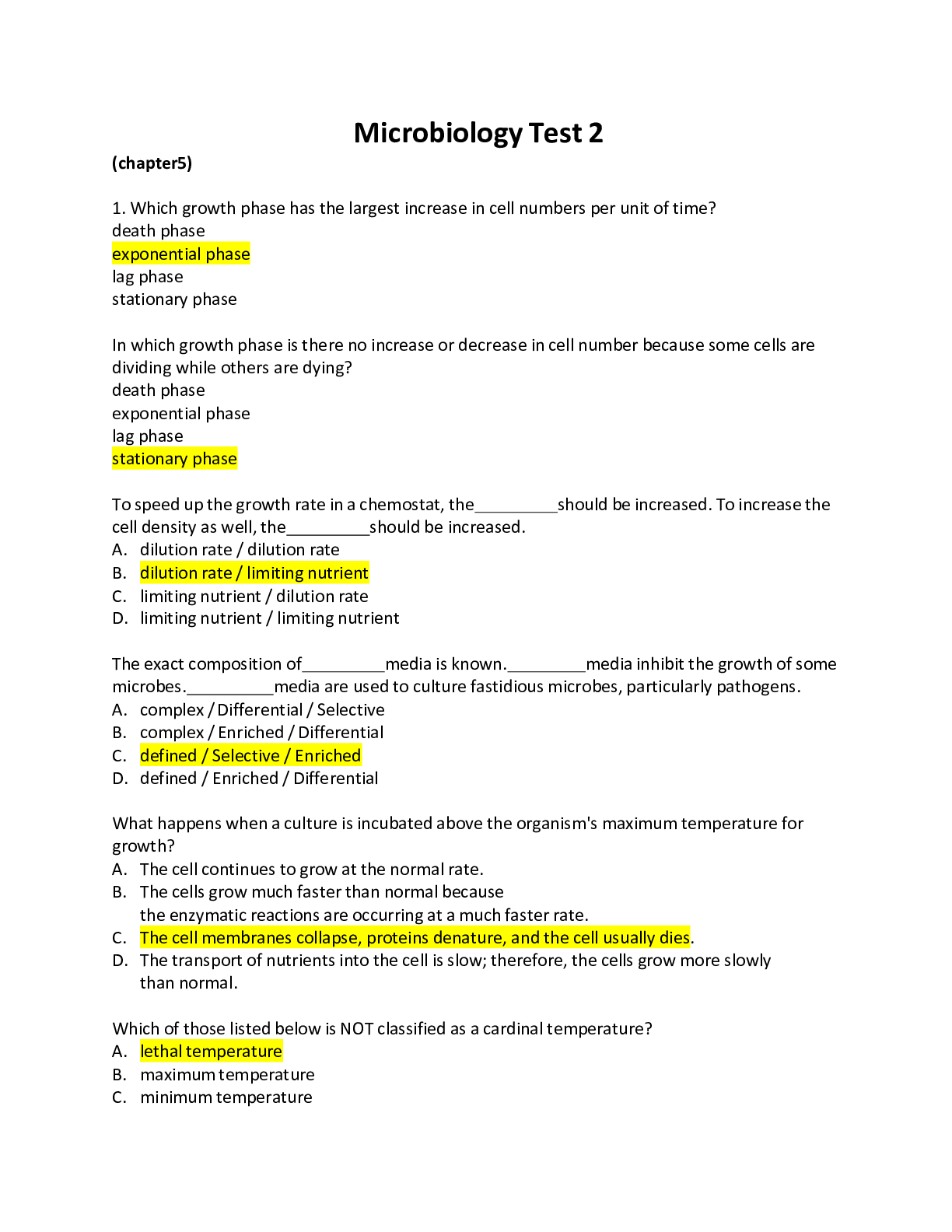
Reviews( 0 )
Document information
Connected school, study & course
About the document
Uploaded On
Oct 05, 2021
Number of pages
37
Written in
Additional information
This document has been written for:
Uploaded
Oct 05, 2021
Downloads
0
Views
31






.png)











